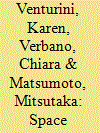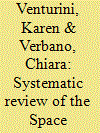| Srl | Item |
| 1 |
ID:
120656


|
|
|
|
|
| Publication |
2013.
|
| Summary/Abstract |
Government organizations have to justify high expenditure during periods of financial crisis such as the one we are experiencing today. Space agencies have attempted to increase the returns on their investments in space missions by encouraging the commercial use of advanced technologies. This paper describes two technology transfer (TT) cases promoted by JAXA, in order to identify the organizational models and determinants of TT. The development of a TT process from space to Earth not only benefits the aerospace industry but also the network of national companies. The aim of the paper is to investigate who the actors are and the nature of their role, as well as the determinants of the TT process in the Japanese space sector. The case studies confirm the typical path of transfer as 'Earth-space-Earth'.
|
|
|
|
|
|
|
|
|
|
|
|
|
|
|
|
| 2 |
ID:
127543


|
|
|
|
|
| Publication |
2013.
|
| Summary/Abstract |
The following paper reports the results of a research work carried from 2008 on the topic of strategies and determinants of space technology Transfer (TT). In particular, the aim of this study is to present: 1. The policies and strategies the major space agencies adopt for TT, 2. The operational mechanisms and determinants involved in the transfer of space technologies to other industrial sectors. To this extent we have conducted in the last five years: six case studies of large space agencies, four TT case studies concerning the construction of scientific satellites, two case studies focused on space to earth TT programs undertaken by the Japanese aerospace agency, and two TT case studies examining Italian space companies.
The comparative and comprehensive analyses of these studies indicate that the space agencies of the more industrialized countries aim primarily at consolidating and developing the industrial systems in their own countries, which include the use of technology transfer programs, and that the transfer of space technologies follows the route "Earth-Space-Earth". With regard to the determinants of the TT process, the most important of these correlate with the type of technology in transfer, whereas organizational, economic and financial determinants have less significance.
|
|
|
|
|
|
|
|
|
|
|
|
|
|
|
|
| 3 |
ID:
132722


|
|
|
|
|
| Publication |
2014.
|
| Summary/Abstract |
In order to justify high expenditure during this period of financial crisis, Space Agencies have attempted to increase the returns on their investments in Space missions by encouraging the commercial use of advanced technologies. The development of a technology transfer process from Space to Earth not only benefits the Aerospace industry but also the network of national companies. Technology transfer has been shown to stimulate innovation in business and commerce, support economic growth and provide a return on public investment in research and development (R&D). The aim of this paper is to systematically review the Space technology transfer literature and to suggest directions for future research. The range of research and studies in the literature on this topic requires a systematic review to summarize the results in an unbiased and balanced manner and to interpret these in a way that highlights the research gaps. This article presents an overview of the dominant thinking (explicit in selected articles from 1995 to present), indicating the problems of analysis, research gaps and a future research program.
|
|
|
|
|
|
|
|
|
|
|
|
|
|
|
|